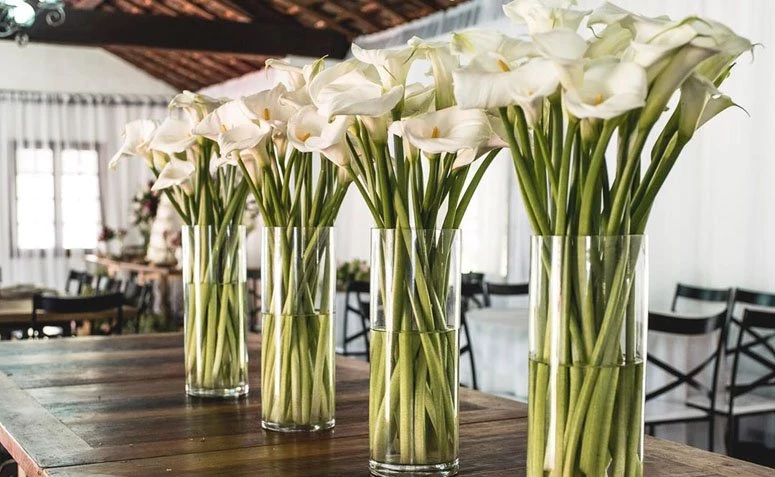Table of contents

The milk cup flower is an ornamental plant that enchants with its delicate lines, exotic appearance, and velvety petals. Its popular name is due to its cup-like shape. It is a very popular species and is widely used to decorate environments, embellish events, and give gifts to loved ones.
Although the white color is the best known, this plant has other types with different shades. To find out more about this much admired flower, check out its meaning, learn how to care for it, explore its various colors, and see some of its curiosities.
Meaning of cop-of-milk
The copo-de-leite has the scientific name of Zantedeschia aethiopica Its presence also brings happiness and prosperity. In addition, it is a flower often used to decorate weddings and bridal bouquets, as it represents purity and sanctity in the marriage union.
Besides being beautiful, it has several symbolisms, and for this reason it is very sought after for weddings. Anyway, it is a very inspiring, elegant, and sophisticated plant for the most diverse occasions.
How to care for copo-de-leite
This plant does not demand great gardening techniques, but requires attention and some simple care in its cultivation:
Cultivation tips
The cultivation of copo-de-leite can be done in garden beds or in pots. To properly care for this charming plant, see more information about its main characteristics and important tips on climate, lighting, watering, soil, fertilization, pruning, and reproduction.
How to care for
Discover a little more about this plant, its origin, and its particularities.
Cultivation Information
This other video also has a lot of information about the plant and tips for growing it. It is a good way for you to learn more about the species, the proper type of soil and light, as well as how it reproduces. Enjoy all the beauty of this enchanting flower!
Tips on how to care for calla
The milkweed can also be found in several colors. Its colorful variations are known as Calla and bloom mainly in spring and summer. Check out quick tips about this species and learn how to grow it in pots, planters, or flowerbeds.
Growing Tips for Colored Milk Cups
Complement your knowledge of Calla with more information about this variety. See the composition for ideal soil preparation and tips on watering and lighting to care for it correctly and thus ensure beautiful, colorful, and showy blooms.
The milkweed is a plant that requires simple care to maintain its beauty and with all these tips, you can easily grow this plant in beds or pots in the garden.
See_also: 50 wood ofuro ideas for relaxing in styleMilkcup Colors
Its flower is originally white, but with the development of techniques in laboratories, it was possible to create specimens of other shades. Explore the variety of colors of the plant below:
- White milk cup: is the most common and original color of the plant. This shade is often used in wedding decoration. Its cultivation is also appreciated in pots and gardens.
- Yellow milk cup: This type stands out with its golden yellow flower and is widely used as a cut flower for bouquets and arrangements.
- Green cup-of-milk: Its flowers are white with a large green spot at the tip. Its distinctive look is an attraction for decoration. It can be planted in pots and in humid places, such as on the banks of water mirrors.
- Orange cup-of-milk: Its orange coloring is vibrant and resembles the appearance of a flame. It is widely used as a cut flower for its long duration.
- Red cup: Its red tone is intense and vivid. It can be used for ornamentation of gardens and arrangements.
- Pink cup-of-milk: is a delicate looking type with its light pink flower color, a lovely plant for the composition of bridal bouquets.
- Copo-de-lite black: This type has an intense, dark burgundy hue. Its exotic color brings a rare beauty to arrangements and gardens.
This plant impresses with its great variety of colors. Its different shades are of unique beauty and fascinate in the composition of arrangements or gardens.
5 curiosities about the milk cup plant
This is a species that has many curiosities:
- It is also popularly known as calla, pitcher, or Nile lily, and despite the similar name, it is an entirely different plant from the lily;
- It is a species native to southern Africa, where it is very common in humid places, such as river and lake shores;
- The colorful variations of this plant are known as calla copa and come in a huge variety of shades, sizes, and dimensions;
- It is necessary to be careful with children, animals, and also in its handling due to the presence of calcium oxalate, a toxic substance found in the plant;
- Despite being a sophisticated and charming plant, the milk-cup flower was once considered a wild plant with no commercial value because it thrives in swamps and in dirty places near sewers.
After learning more about this plant and learning how to care for it correctly, you can now grow specimens in your garden or in pots.
Be that as it may, this species is a much admired plant and has its special place in the composition of flowerbeds, as adornment for weddings, and as decorations for the home.


